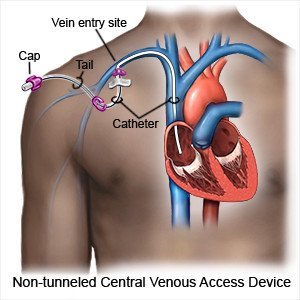Non-Tunneled Central Lines
Medically reviewed by Drugs.com. Last updated on Aug 4, 2025.
A non-tunneled central line is a short-term IV catheter placed into a large vein near your neck, chest, or groin. You will need to flush and care for your central line as directed.
 |
DISCHARGE INSTRUCTIONS:
Call your local emergency number (911 in the US) for any of the following:
- You have pain in your arm, neck, shoulder, or chest.
- You cough up blood.
- You have chest pain or trouble breathing.
Seek care immediately if:
- You feel pain in your arm, neck, shoulder, or chest.
- The catheter site is cold, changes color, or you cannot feel it.
- You see blisters on the skin near the catheter site.
Call your doctor if:
- You have a fever.
- The catheter site is red, warm, painful, or is oozing fluid.
- You see blood on your bandage and the amount is increasing.
- The veins in your neck or chest bulge.
- You cannot flush your catheter, or you feel pain when you flush your catheter.
- You see that the catheter is getting shorter, or it falls out.
- You see a hole or a crack in your catheter. Clamp your catheter above the damage before you call your doctor.
- You have questions about how to care for your catheter.
Medicines:
- NSAIDs , such as ibuprofen, help decrease swelling, pain, and fever. This medicine is available with or without a doctor's order. NSAIDs can cause stomach bleeding or kidney problems in certain people. If you take blood thinner medicine, always ask if NSAIDs are safe for you. Always read the medicine label and follow directions. Do not give these medicines to children younger than 6 months without direction from a healthcare provider.
- Take your medicine as directed. Contact your healthcare provider if you think your medicine is not helping or if you have side effects. Tell your provider if you are allergic to any medicine. Keep a list of the medicines, vitamins, and herbs you take. Include the amounts, and when and why you take them. Bring the list or the pill bottles to follow-up visits. Carry your medicine list with you in case of an emergency.
What you need to remember about the central line:
The following can help prevent an infection or other problems:
- Clean and change the catheter parts as often as directed. You will be shown how to clean the caps, hubs, and injection ports. Always clean the parts before you attach and after you remove tubing from your catheter. Use a new alcohol pad for each part you clean. Ask your healthcare provider how often to change the caps and the medicine tubing.
- Flush your catheter before and after you use the central line. Your healthcare provider may give you syringes filled with saline (salt water) or heparin (a blood thinner) to flush your catheter. Stop if it is difficult to push the plunger. Do not force the saline or heparin into your catheter. This could damage the catheter or your vein. The force could also cause a blood clot to move into your blood. Stop when about 1 milliliter (mL) is left in the syringe. This will keep any air bubbles in the syringe.
- Clamp the catheter as needed. You may need to clamp your catheter at certain times, such as when the caps and tubing are being changed. The catheter is clamped to help prevent air from getting in.
- Loop and secure extra tubing. Loosely loop the tubing. Secure it to your arm with medical tape. This will help prevent the catheter from being pulled out by accident.
- Ask about activity. Your healthcare provider will tell you which activities are safe for you. You may not be able to play contact sports until the catheter is removed.
Prevent an infection:
The area around your catheter may get infected, or you may get an infection in your bloodstream. A bloodstream infection is called a central line-associated bloodstream infection (CLABSI). A CLABSI is caused by bacteria getting into your bloodstream through your catheter. This can lead to severe illness. The following are ways you can help prevent a CLABSI:
- Wash your hands often. Use soap or an alcohol-based hand rub to clean your hands. Clean your hands before and after you touch the catheter or the catheter site. Remind anyone who cares for your catheter to wash their hands.

- Limit contact with the catheter. Do not touch or handle your catheter unless you need to care for it. Do not pull, push on, or move the catheter when you clean your skin or change the dressing. Wear clean medical gloves when you touch your catheter or change dressings.
- Keep the area covered and dry. Keep a sterile dressing over the catheter site. Wrap the insertion site with plastic and seal it with medical tape before you bathe. Take showers instead of baths. Do not swim or soak in a hot tub.
Follow up with your doctor as directed:
You may need to have the stitches taken out. Write down your questions so you remember to ask them during your visits.
© Copyright Merative 2025 Information is for End User's use only and may not be sold, redistributed or otherwise used for commercial purposes.
The above information is an educational aid only. It is not intended as medical advice for individual conditions or treatments. Talk to your doctor, nurse or pharmacist before following any medical regimen to see if it is safe and effective for you.
Further information
Always consult your healthcare provider to ensure the information displayed on this page applies to your personal circumstances.
